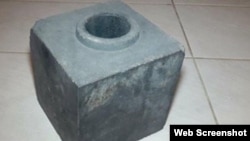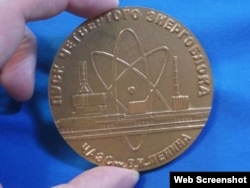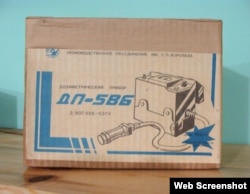The popularity of the HBO miniseries Chernobyl has bolstered a niche market within an online cottage industry -- the sale of Soviet-era memorabilia linked to the infamous 1986 nuclear power-plant disaster.
To be sure, vendors say online demand for vintage communist-era relics has been booming during the past decade, driven mostly by buyers in the United States.
It’s been a lucrative business for sellers in former Soviet republics who work out of their homes and have easy access to an industrial supply of Soviet-era artifacts.
Even with export duties, they say, they’ve been able to turn profits of up to 500 percent on legitimate Soviet articles sold via online marketplaces like eBay and Etsy.
Now, since the broadcast in May and June of the five-part Chernobyl miniseries, cunning online vendors have been racking up sales by adding the words "Chernobyl" or "Chernobyl-type" to items in their website listings.
The Soviet "liquidator" medals given to workers who helped clean up the Chernobyl site and the surrounding area after the April 1986 nuclear accident are the most common item being sold online.
Some 600,000 of the medals were awarded to soldiers, rescuers, firefighters, police, and civilian workers during the Soviet era.
One seller in Ukraine who hoarded a large supply of the medals had been selling them sporadically since July 2015.
But after broadcasts of the Chernobyl miniseries began in May, his sales went into hyperdrive with nearly 700 sold for about $11 each.
Vendors in the United Kingdom have been reselling the same medals for up to twice that price since May.
In the $10 to $40 price range, Western buyers also have been grabbing up Soviet military medals linked to the catastrophe, along with Chernobyl commemorative coins minted as recently as 2016.
A Ukrainian online vendor in June was auctioning off a pre-catastrophe Soviet medallion minted in 1983 to mark the launch of Chernobyl’s ill-fated fourth reactor.
By June 12, with three days left to go in the auction, he’d received a top bid of $48.
A more unique metal bas-relief medallion, made in February 1988 and given to a Soviet soldier who took part in cleanup operations within the Chernobyl exclusion zone, was being sold on eBay in June by a vendor from Kyiv for $700.
Soviet-made dosimeters used to measure radiation levels have been selling steadily in recent weeks at starting bids of about $50.
One seller with a stockpile of Soviet military documents used to register radiation exposure of soldiers and surgeons has sold dozens of the unfilled forms for $2 each.
There is no direct connection between the Chernobyl plant and the unused forms, which contain the Soviet Army’s red star with a hammer and sickle.
But they are the same document that would have been filled out by military officers for personnel under their command at all Soviet nuclear facilities, including the Chernobyl site.
The type of Soviet military gas masks issued to Chernobyl workers, which were common across the entire Soviet Union, have been selling in recent weeks at prices ranging from $20 to $50.
Meanwhile, a seller in the United Kingdom has sold nearly 300 complete gas mask and radiation-protection suits for about $85 each after listing them as "surplus Chernobyl fallout HAZMAT suits."
In one of the most remarkable online solicitations, a Ukrainian eBay vendor on May 31 asked $2,800 for what he claimed was an "original Soviet USSR Chernobyl nuclear reactor RBMK-1000 core graphite block."
The authenticity of the item could not be independently confirmed. The seller did not offer any documentation other than photographs of the block and a tape measure showing it to be a 20-centimeter cube with a cylindrical hole.
Dana Drabova, a 58-year-old nuclear physicist who heads the Czech Republic’s State Office for Nuclear Safety, told the Czech magazine Reflex that it could be a legitimate graphite block from a Chernobyl-type RBMK nuclear reactor.
Out of 17 of the Soviet-designed RBMK reactors commissioned and put into operation since the 1970s, 10 are still functioning today -- all in Russia -- albeit with modifications to correct safety flaws in the original Soviet design.
Drabova noted that Russia continues to produce graphite core blocks for the functioning reactors at the Smolensk, Kursk, and Leningrad nuclear power plants.
Although the vendor claimed the block posted on eBay "was never used in a nuclear reactor core" because it was "from a closed laboratory" in the Chernobyl area, Drabova advised anyone buying it to measure its radiation level with a dosimeter.
Her advice proved to be superfluous.
The eBay website allows documents, medals, and protective clothing to be sold on its pages, but it prohibits the sale of radioactive or contaminated nuclear materials.
By June 4, a day after HBO aired the final episode of the Chernobyl miniseries, eBay had removed the alleged Chernobyl reactor core block from its site.












